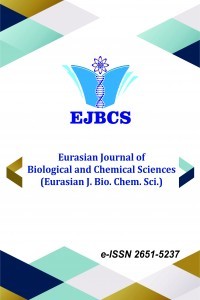Real-Time Monitoring the Indoor Air Quality Parameters of Intensive Care Unit During the Pandemic Period
Real-Time Monitoring the Indoor Air Quality Parameters of Intensive Care Unit During the Pandemic Period
___
- Against F, Turan A. 2020. Türkiye ’ de KOVİD - 19 ile Mücadele : Politikalar ve Aktörler 1–25.
- Aktaş Ö, Milli Mehmet, Lakestani S, Milli Musa. 2020. Modelling sensor ontology with the SOSA/SSN frameworks: a case study for laboratory parameters. TURKISH J. Electr. Eng. Comput. Sci. 28, 2566–2585. https://doi.org/10.3906/elk-1912-160.
- Baurès E, Blanchard O, Mercier F, Surget E, le Cann P, Rivier A, Gangneux JP, Florentin A.2018. Indoor air quality in two French hospitals: Measurement of chemical and microbiological contaminants. Sci. Total Environ. 642, 168–179. https://doi.org/10.1016/j.scitotenv.2018.06.047.
- Chen J, Hoek G. 2020. Long-term exposure to PM and all-cause and cause-specific mortality: A systematic review and meta-analysis. Environ. Int. 143, 105974. https://doi.org/10.1016/j.envint.2020.105974.
- Fernández E, Martínez C, Fu M, Martínez-Sánchez JM, López MJ, Invernizzie G, Ouranou A, Dautzenberg B, Nebot M. 2009. Second-hand smoke exposure in a sample of European hospitals. Eur. Respir. J. 34, 111–116. https://doi.org/10.1183/09031936.00180708.
- Guidelines on energy efficiency of cultural heritage - ScienceDirect, 1998.
- Heibati B, Rivas I, Veysi R, Hoek G, Perez-Martinez PJ, Karimi A. 2021a. Evaluating size-fractioned indoor particulate matter in an urban hospital in Iran. Environ. Monit. Assess. 193, 1–10. https://doi.org/10.1007/s10661-021-09327-0.
- Heibati B, Rivas I, Veysi R, Hoek G, Perez-Martinez PJ, Karimi A. 2021b. Evaluating size-fractioned indoor particulate matter in an urban hospital in Iran. Environ. Monit. Assess. 193, 1–10. https://doi.org/10.1007/s10661-021-09327-0.
- Hwang SH, Roh J, Park WM. 2018. Evaluation of PM10, CO2, airborne bacteria, TVOCs, and formaldehyde in facilities for susceptible populations in South Korea. Environ. Pollut. 242, 700–708. https://doi.org/10.1016/j.envpol.2018.07.013.
- Interior Republic of Turkey Ministry of, 2020. Additional Circular on Markets in the Scope of Combating the Coronavirus Outbreak [WWW Document].
- Jeong JY, 2012. Recently issues on Indoor air quality in Korea.
- Karakas B, Lakestani S, Guler C, Dogan BG, Vaizoglu SA, Taner A, Sekerel B, Tıpırdamaz R, Gullu G. 2013. Indoor and Outdoor Concentration of Particulate Matter at Domestic Homes. World Acad. Sci. Eng. Technol. 7, 222–229.
- Kim KH, Kabir E, Kabir S. 2015. A review on the human health impact of airborne particulate matter. Environ. Int. 74, 136–143. https://doi.org/10.1016/j.envint.2014.10.005.
- Lakestani S, Karakas B, Acar Vaizoglu S, Dgan GB, Cagatay G, Sekerel B, Taner A, Gullu G. 2013. Comparison of Indoor and Outdoor Air Quality in Children Homes at Prenatal Period and One Year Old. J. Civil, Environ. Struct. Constr. Archit. Eng. 7.
- Loupa G, Zarogianni AM, Karali D, Kosmadakis I, Rapsomanikis S. 2016. Indoor/outdoor PM2.5 elemental composition and organic fraction medications, in a Greek hospital. Sci. Total Environ. 550, 727–735. https://doi.org/10.1016/j.scitotenv.2016.01.070.
- Pickett AR, Bell ML. 2011. Assessment of indoor air pollution in homes with infants. Int. J. Environ. Res. Public Health 8, 4502–4520. https://doi.org/10.3390/ijerph8124502. Stern RA, Al-Hemoud A, Alahmad B, Koutrakis P. 2021. Levels and particle size distribution of airborne SARS-CoV-2 at a healthcare facility in Kuwait. Sci. Total Environ. 782, 146799. https://doi.org/10.1016/j.scitotenv.2021.146799.
- Tucker WG. 2002. ASHRAE® Standard: Ventilation for Acceptable Indoor Air Quality, ASHRAE Standard.
- Wang X, Bi X, Sheng G, Fu J. 2006. Hospital indoor PM10/PM2.5 and associated trace elements in Guangzhou, China. Sci. Total Environ. 366, 124–135. https://doi.org/10.1016/j.scitotenv.2005.09.004.
- Wingate, n.d. Title: Importance of Monitoring and Controlling Temperature and Humidity in Hospitals [WWW Document]. URL https://blog.rotronic.com/2014/09/15/importance-of-monitoring-and-controlling-temperature-and-humidity-in-hospitals/
- Yayın Aralığı: Yılda 2 Sayı
- Başlangıç: 2018
- Yayıncı: Muhammet DOĞAN
Ibrahim FİLAZİ, Ali Tuncay OZYİLMAZ
Effect of vitamin B3 supplementation on glutathione redox cycle
Fe3O4@-KRG-aşı-PDMAEMA manyetik nanopartiküllerden pH kontrollü doksorubisin salımı
Diphenylcarbazone and tartrazine as sensitizer metal complex dyes for dye sensitized solar cells
Burak ÜNLÜ, Serbülent TÜRK, Mahmut ÖZACAR
Kamkatın muhafazası ve çeşitli gıdaların üretiminde kullanımı
Sanaz LAKESTANI, Mehmet MİLLİ, İsa YILDIZ, Abdullah DEMİRHAN
